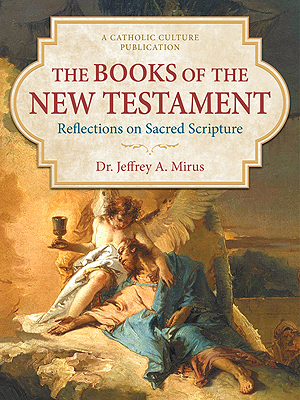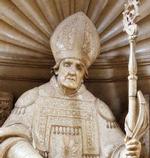September or Fall Ember Days
By Jennifer Gregory Miller ( bio - articles - email ) | Sep 17, 2019 | In The Liturgical Year
The 2022 September Ember Days begin on Wednesday, September 21.
From the Archives of September 2015:
Football games and pumpkin spice beverages and foods return; Autumn is upon us. Sadly, that is only what the fall season means to so many people. We have lost contact the actual natural signs of the seasons of the year and turn to manmade expressions as signals for the change of seasons. But a pumpkin spice latte and football game aren’t true signals of the season change, because the specially-flavored latte tends to return earlier each year, and added pre-season games blur the true end of summer and beginning of Fall.
Free eBook:

|
| Free eBook: The Books of the New Testament |
Once again, I turn to the Church’s Ember Days as an aid to looking at nature and the change of seasons and recognizing them all as a gift from God. Ember Days are a quarterly observance the Wednesday, Friday and Saturday of one week of each season that “the Church is accustomed to entreat the Lord for the various needs of humanity, especially for the fruits of the earth and for human labor, and to give thanks to him publicly.” (Universal Norms on the Liturgical Year and the Calendar, 45). In addition, the Church provides us two seasons of preparation, Advent and Lent. Both seasons are a time for change of heart and renewal. But naturally the change of seasons seem to tug and encourage us for renewal and change (spring and fall cleaning, anyone?). Although not required, the traditional fasting and abstaining of these days are an external expression of turning our hearts and focusing back to God.
Practicing Ember Days is not intended to be a backward-looking movement or living in the past. Ember Days are still a part of the Church’s tradition. There is an unbroken continuum within the Church’s Liturgy. Ember Days may look a bit different than pre-Vatican II (but even before 1962 Maria von Trapp was bemoaning how they were different and disappearing in her contemporary 1955 America), but the Ember Days are still a part of the Church’s living tradition.
Ember Days are part of the agrarian heritage of our Faith. The Church recognizes our dependency on God for His gifts of nature. The Liturgy has reflects this connection with nature and God. Before man become so civilized, weather, crops, farm animals and the change of seasons were a part of daily life for everyone. Not everyone lived in rural locations, but there was a recognition of that connection of the land to our life. The agrarian connection also recognized that while man could work the land, he can never control the elements. Returning to our agricultural roots brings true humility in remembering man’s role on earth as being completely beholden to God. The gift of nature is from God, and man is not and can never be in control of it.
While Liturgy always has the balance of the four forms of prayer: adoration, contrition, thanksgiving and supplication, our personal prayers tend to lean heavily on the petition form. The Ember Days were a time dedicated to continuing that petition to help us with our needs, especially with harvests, but also stressing on giving gratitude to God for His generous gifts.
The September Ember Days were one of the first Ember Days established, and they are the most prominent of the quarterly days. The Ember Days in September are outside the main liturgical seasons (Advent, Christmas, Lent and Easter) and are closest to the Fall Equinox. The Church recognized the pattern of change of seasons and bringing in the harvest man needs to give thanks and renew our hearts.
This year (2015) the Ember Days do not fall this week right after the Feast of the Holy Cross, but the next week. In 1960 under Pope St. John XXIII, the rules for establishing the dates for Ember Days changed, and connected the Ember Days to follow the Third Sunday of September, which will be September 21, 23 and 24, 2015. The changes corresponded to following the Divine Office or Breviary.
The public practice of Ember Days within the diocese or parish is dependent on the local Ordinary, so there are many locations that do not observe Ember Days at all. But that doesn’t mean that Ember Days can’t be observed in small ways in our domestic churches. I have written about this several times, so I won’t belabor the point. There are prayers, food, decorations and activities that can easily be incorporated by your family. Even if no extra external activities or food are added, the Ember Days can be a simple three day exercise of remembering to look with wonder at our gifts of nature from God, see the connections in our life, and to use this time to turn our hearts in praise and thanksgiving.
My other posts on the Ember Days:
- Contemporary Observation of Ember Days
- Rejoice the Lord is Near! Gaudete Sunday, Ember Days and O Antiphons
- Lenten Ember Days
- Summer or Pentecost Ember Days
- A Year of Repentance and Ember Days
For Further Reading and Meditation:
- Description of Ember Days by Bernard Strasser
- Explanation of Ember Days by John A. Hardon, S.J.
- Ember Days by Maria Von Trapp
- In the Home: Ember Days by Florence Berger
- Rabbits, Ember Days, and First Fruits by Ade Bethune
- Brief Meditations on the Church Year: Spring or Lent Ember Days by Martin Hellriegel
- Brief Meditations on the Church Year: Fall Ember Days by Martin Hellriegel
- Brief Meditations on the Church Year: Summer or Pentecost Ember Days by Martin Hellriegel
- Ember Days Prayers
All comments are moderated. To lighten our editing burden, only current donors are allowed to Sound Off. If you are a current donor, log in to see the comment form; otherwise please support our work, and Sound Off!







